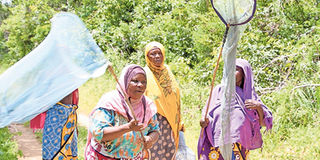Butterflies hatch cash for Coast women

Women butterfly farmers living near the Arabuko-Sokoke Forest in Kilifi demonstrate how they catch the butterflies in the forest for farming. Farming butterflies is a good example of how local communities can be facilitated in conserving forests. PHOTO | BRIAN OKINDA | NATION MEDIA GROUP
What you need to know:
- Butterfly farming is an ideal alternative source of income as it offers a good livelihood for those living near the forest. It also needs little investment.
- The butterflies enter the traps, which are usually made of a meshed material and are confined therein, after which the women collect their harvest and take it home where they have built special structures for rearing them.
- After hatching, the larvae are left to feed on the plants until they develop into pupae, which the farmers sell at the Kipepeo Butterfly Project Centre in Mombasa, which is managed by the East African Natural History Society together with the National Museums of Kenya.
- Hussein Aden, a research scientist at National Museums of Kenya, who is also the project manager at the Kipepeo Butterfly Project, notes that the farming has been a key incentive in boosting the incomes of the largely underprivileged communities living on the fringes of the forest.
For Jamila Rashid, a mother of three from Mida near Gede in Kilifi County, harvesting and selling firewood and charcoal from the vast Arabuko-Sokoke Forest used to be the main source of livelihood.
Together with other women in the village, she would spend hours in the forest gathering firewood and burning charcoal for sale, an exercise which often put them at loggerheads with the Kenya Forest Service (KFS) officials.
However, butterflies later came to their rescue as the women now keep them for a living. The Arabuko-Sokoke Forest is a rich habitat of butterflies with at least 260 species living therein, according to Elvis Fondo, a KFS officer.
An estimated 30 per cent of all the butterfly species found in the country have been recorded to inhabit the forest, says Fondo.
“Butterfly farming is an ideal alternative source of income as it offers a good livelihood for those living near the forest. It also needs little investment,” says Fondo.
To rear the butterflies, Jamila and her colleagues pick the females first using simple traps set in the forest, sometimes with pheromone-scented materials used as bait.
The butterflies enter the traps, which are usually made of a meshed material and are confined therein, after which the women collect their harvest and take it home where they have built special structures for rearing them.
They also sometimes use hand-held nets to catch the butterflies in flight. But this is a tiresome task that entails chasing after the creatures.
At their homes, they have erected butterfly shade-net enclosures of varying sizes depending on the intended number of flies, and are filled with plant leaves, indigenous vegetation as well as chunks of sweet-scented fruits such as ripe mangoes.
The butterflies feed on these in the course of their stay in the enclosures made of wood and wiremesh until they lay eggs, which then hatch into pupae. Each of the farmers has several of the structures at their homes.
“The butterflies lay between 1,000 and 2,000 eggs during their lifespan,” says Jamila.
CONSERVING FORESTS
After hatching, the larvae are left to feed on the plants until they develop into pupae, which the farmers sell at the Kipepeo Butterfly Project Centre in Mombasa, which is managed by the East African Natural History Society together with the National Museums of Kenya.
Once the netted butterflies have hatched, farmers release them back into the forest to ensure sustainability of the insect’s populations.
At the collection centre, the pupae are sorted and classified according to the target market. The grading is based on their species, eminence, as well as whether or not the butterflies have been affected by pests and diseases, including the Ophryocystis elektroscirrha, the tachinid fly, and viral and bacterial diseases such as Black death.
These factors collectively determine the pricing of the pupae, which ranges from Sh25 to Sh70 each depending on its features. The centre then exports the butterfly pupae to countries in Europe and North America, as well as Turkey.
The pupae are also sometimes sold to institutions such as the National Museums of Kenya, which runs live butterfly exhibitions as well as other exhibitors in the country.
Charo Ngumbao, who heads the butterfly farming project in the area, indicates that the species in big demand are the Papilio Swallowtails and the Charaxes, which fetch good prices in the market.
“Things are better for us with the advent of butterfly farming,” he says, indicating that a diligent farmer can earn up to Sh10,000 per week from the creatures.
Hussein Aden, a research scientist at National Museums of Kenya, who is also the project manager at the Kipepeo Butterfly Project, notes that the farming has been a key incentive in boosting the incomes of the largely underprivileged communities living on the fringes of the forest.
“After establishing their individual butterfly farms, many are now earning substantial incomes and are realising the importance of conserving the forest as opposed to engaging in charcoal trade,” he says.
Griet Ingrid Dierckxsens, who works with the United Nations Programme on Reducing Emissions from Deforestation and Forest Degradation, says that farming butterflies is a good example of how local communities can be facilitated in conserving forests.





